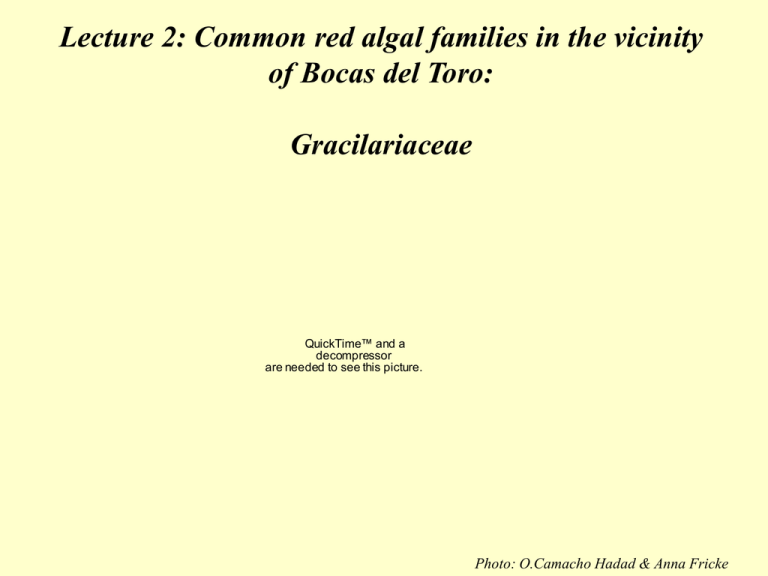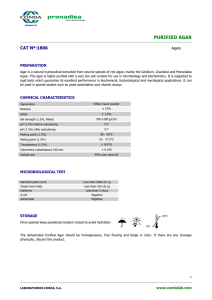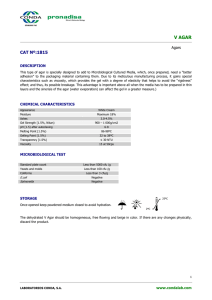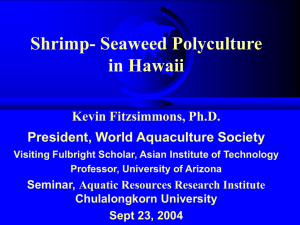22 Lecture2 Focus on CommonFamilies Gracilariaceae SuzanneFredericq
advertisement

Lecture 2: Common red algal families in the vicinity of Bocas del Toro: Gracilariaceae QuickTime™ and a decompressor are needed to see this picture. Photo: O.Camacho Hadad & Anna Fricke Gracilariaceae Halymeniaceae Rhodymeniaceae family, ordinal level vegetative structure: cellular medulla Gracilaria terete sp. Hydropuntia mixed-sized cells flat sp. Solieriaceae Gracilariaceae Solieriaceae (Solieria) loose filiform, or mixed cellular-filiform medulla Halymeniaceae (Cryptonemia) 2 1 2 3 1 -cortical unit of 3 surface cells Conjunctor cells fuse with neighboring cells, resulting in secondary pit connection formation -inherently uniaxial -uniaxial growth quickly disguised -axial cells: same shape as medullary cells Generic distinction: -comparative post-fertilization events of female reproductive system in establishment of cystocarp: nature of fusions - complexity of male reproductive system Gracilaria intermedia cystocarps pericarp carposporangia inner gonimoblast cystocarp floor medulla Gracilaria: multinucleate tubular nutritive cells to roof, to base Gracilariopsis: uninucleate conjunctor cells at base “TAPPING BACK” Gracilariophila (parasite) Hydropuntia: multinucleate tubular nutritive cells at base of cystocarp 2 1 3 1 unfertilized female structure -origin: 3-cortical unit again -lower cell of unit = cell 1 = supporting cell cutting off carpogonial branch initial -cells 2 & 3 = nutritive cells of carpogonial branch unit unfertilized 2-celled carpogonial branches -2-celled carpogonial branch on supporting cell -straight trichogyne reaching thallus surface -partly fusion of cortical nutritive cells to carpogonium Partly fusion of neighboring cortical cells with carpogonium; vegetative nuclei remain in unfused portion -diploid zygote nucleus in uninucleate carpogonium; -fused cortical cells = nutritive cells -young carpospore-bearing filaments (gonimoblasts) cut off from carpogonial fusion cell Generic character: How lower cells of young carpospore-bearing filaments fuse back to multinucleate carpogonial fusion cell young cystocarp: Gracilariopsis -very regular, progressive growth of carposporebearing filaments Fusion of lower carposporophyte cells to vegetative gametophytic cells Gracilariopsis Gracilaria: multinucleate tubular nutritive cells to roof, to base Gracilariopsis: uninucleate conjunctor cells at base “TAPPING BACK” Gracilariophila (parasite) Hydropuntia: multinucleate tubular nutritive cells at base of cystocarp Gracilaria: Gracilariopsis: in shallow or deep pits superficial Gracilariophila: Hydropuntia: male structures in deep pits, connecting to vegetative cells Gurgel & Fredericq 2004 = rbcL phylogeny of the Gracilariaceae, Bayesian Tree. Global Phylogeny of the Gracilariaceae Bayesian Inferred Phylogeny Gurgel & Fredericq 2004 A meaningful global phylogeny of the Gracilariaceae and the evolutionary patterns found in it could only be obtained after reaching a dataset composed of 35+ taxa Before that, taxa sampling played a major issue in obtaining stable and meaningful phylogenies. So, nowadays, when new taxa (i.e. distinct rbcL DNA sequences) are added to the global phylogeny they do not change the overall topology. Ready for final taxonomic conclusions. Gurgel & Fredericq 2004 Bayesian Tree Genera: What has been established so far? Gracilaria 97 Hydropuntia 94 ‘New Genus’ G. beckeri G. textorii 91 G. ornata 97 G. bursa-pastoris G. cervicornis G. tikvahiae G. mammillaris G. canaliculata G. salicornia 75 G. gracilis G. pacifica G. acuelata H. aff. changii H. aff. changii H. changii H. crassissima H. cornea H. caudata H. secundata 89 H. perplexa 82 99 H. preissiana H. edulis H. rangiferina H. millardetii H. eucheumatoides H. urvillei G. tenuistipitata G. tenuistipitata G. tenuistipitata G. tenuistipitata G. tenuistipitata 85 G. chilensis G. chilensis G. vermiculophylla G. vermiculophylla Gp. hommersandii (outgroup) 83 67 Sub-Genera: Textorii-type spermatangia Verrucosa-type spermatangia Rounded carposporophyte Lobed carposporophyte Chilensis-type spermatangia ‘Verrucosa’-type spermatangia Is high quality-agar (gel strength) correlated to phylogeny? Is there character congruence between agar gel strength (phenotype) and molecular-based phylogenies (haplotype)? Can sound phylogenies identify lineages characterized by high-quality agar? Gurgel & Fredericq 2004 69 54 52 92 99 74 G. beckeri SOUTH AFRICA G. capensis SOUTH AFRICA G. viellardii TAIWAN G. spinulosa TAIWAN G. sp . PHILIPPINES 79 G. flabelliformis VENEZUELA 85 G.occidentali s LA, USA G. ornata PANAMA 96 G. textorii JAPAN G. multipartita FRANCE G. bursa-pastori s ITALY 97 89 G. apiculata VENEZUELA 88 G. domingensi s BRAZIL G. cervicornis FL, USA G. curtissae VENEZUELA 100 G. tikvahiae CANADA 98 G. lacinulat a VENEZUELA G. damaecornis FL, USA 98 100 G. cuneata FL, USA 97 cuneata PANAMA 99 G.G.sp. PANAMA G. sp. VENEZUELA 94 G. sp. PANAMA G. mammillaris LA, USA G. sp. BRAZIL 100 G. intermedia VENEZUELA 100 G. venezuelensis FL, USA 73 G. canaliculata PHILIPPINES G. salicornia PHILIPPINES G. arcuata PHILIPPINES G. gracilis ENGLAND 100 G. gracilis FRANCE 100 G. pacifica WA, USA 98 G. usneoide s MEXICO G. crassissima PANAMA 100 G. cornea VENEZUELA 100 G. caudata FL, USA 100 G. secunda FL, USA 95 G. edulis PHILIPPINES G. preissiana AUSTRALIA 100 G. dentata GHANA 100 G. dentata PHILIPPINES G. eucheumatoides PHILIPPINES 100 G. urvillei i AUSTRALIA G. tenuistipitata JAPAN 100 G. tenuistipitata VA, USA G. chilensis CHILE 100 G. vermiculophylla G. tenuistipitata G. chilensis (90% agar worldwide, Zemke-White & Ohno 1999) Proposed as a distinct genus by Gurgel & Fredericq 2004 Agar Properties: Yield Gel Strength 3,6 Anhydro-galactose Gelling Point Boiling Point ( %, dw/dw ) ( g. cm-2 ) ( %, dw/dw ) ( °C ) ( °C ) Data in the Literature: 1st Source of Variation: (in the Agar Properties) Strain / population ‘Tissue’ / Thallus Age Light Regime Temperature Life-cycle Reproductive status 2nd Source of Variation: ≠ Methodologies (Whyte et al. 1984): * Extraction: Standard vs. Alkali * Strength: gel shape, Ø and crosshead speed (plunger) * 3,6 AG: Resorcinol vs. IR Spectrophotometer Fred Gurgel, pers. comm Searching for Phylogenetic Patterns of Native Gel Strengths Sampling for Published Data: • Obtain agar parameters for species for which we have phylogenetic data (= rbcL DNA sequences). • Select methodologies that reflect the algae’s most natural conditions. – Extraction: Standard (shredding boiling gelling freezing thawing washing) – Strength method: 1.5% gels, 1.0 cm Ø plungers • Minimize Method Variation Total number of Papers Surveyed = Total number of Papers Selected = 26 09 Fred Gurgel, pers. comm 800 Gel Strength 600 (g. cm-2) 400 200 0 1 2 3 4 5 6 7 8 9 10 11 Number of species with comparable agar data G. chilensis Clade Gracilariopsis Clade Gracilaria s. s. Clade Fred Gurgel, pers. comm Conclusions • RbcL-based phylogenies reevaluated character evolution in the Gracilariaceae and inferred a new classification for Gracilaria sensu lato. • The G. chilensis-clade and the genus Hydropuntia are reinforced as distinct taxa in the Gracilaria complex. • Based on a literature review, data suggest that there is a strong correlation between phylogeny and agar gel strength (agar quality) between genera, and between average genetic divergence and gel strength values within each genus. ordinal & family-level characters: -based on how unfertilized female system develops in relation to vegetative growth cf. Kylin system Gracilaria: multinucleate tubular nutritive cells to roof Gracilariophila (parasite) Gracilariopsis: uninucleate conjunctor cells Hydropuntia: multinucleate tubular nutritive cells at base of cystocarp Problem: *differentiate among stages that are are functional, versus abortive?? *no auxiliary cells! Gracilaria: male structure development Gracilaria: male structure development Gracilaria: male structure development Gracilaria: male structure development Gracilaria: male structure development Gracilaria: male structure development Gracilariopsis: male structure development all genera: -tetrasporangial initials are surface cortical cells -cruciate divisision of tetrasporangia Gracilariaceae from the vicinity of Bocas del Toro Gracilaria curtissiae -thick thallus; thinner lateral blade-like proliferations Photo: A. Fricke & O. Camacho-Hadad Photo: A. Fricke & O. Camacho-Hadad Gracilaria intermedia Gracilaria intermedia Photo: A. Planas & C. Fernández) Gracilaria cervicornis Photo: M.C. Díaz Ruiz Photo: R. Fikes Gracilaria domingensis QuickTime™ and a decompressor are needed to see this picture. Photo: A. Fricke & O. Camacho-Hadad Hydropuntia caudata Gracilaria galetensis Gracilaria hayi Global Phylogeny of the Gracilariaceae Bayesian Inferred Phylogeny GTR+inv+gama 100,00 generations, 4 chains Burn in = 20,000 Gurgel & Fredericq 2004



